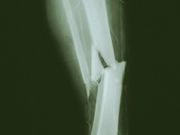Risk associated with RYGB manifested more than two years after surgery; increased in subsequent years
TUESDAY, March 7, 2017 (HealthDay News) — Roux-en-Y gastric bypass (RYGB) is associated with increased nonvertebral fracture risk compared with adjustable gastric banding (AGB), according to a study published online March 2 in the Journal of Bone and Mineral Research.
Elaine W. Yu, M.D., from Massachusetts General Hospital in Boston, and colleagues compared fracture risk in obese adults after RYGB and AGB procedures using claims data from a U.S. commercial health plan. They examined rates of nonvertebral fractures within a propensity-score matched cohort of 15,032 morbidly obese adults who underwent RYGB or AGB surgery from 2005 to 2013.
During a mean follow-up of 2.3±1.9 years there were 281 nonvertebral fractures. The researchers found that compared with AGB patients, RYGB patients had increased risk of nonvertebral fracture (hazard ratio, 1.43). RYGB patients had increased risk of fracture at the hip and wrist (hazard ratios, 1.54 and 1.45, respectively) in fracture site-specific analyses. The risk of nonvertebral fracture associated with RYGB manifested more than two years after surgery and increased in subsequent years; the highest risk was seen in the fifth year after surgery (hazard ratio, 3.91).
“Fracture risk should be considered in risk:benefit discussions of bariatric surgery, particularly among patients with high baseline risk of osteoporosis who are deciding between RYGB and AGB procedures,” the authors write.
One author disclosed financial ties to the pharmaceutical industry.
Copyright © 2017 HealthDay. All rights reserved.








